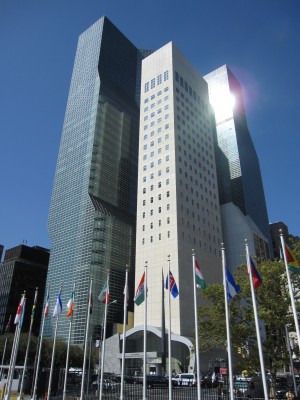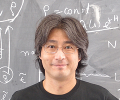
The United Nations Headquarters in New York will be the venue of a Symposium on Science for Peace and Development, featuring Ban Ki-moon, Kofi Annan, Rolf Heuer, Hitoshi Murayama (and others). Image: “1 United Nations Plaza 0948” by Gryffindor – Own work. Licensed under CC0 via Wikimedia Commons.
I was very honoured when I received an invitation to speak at the United Nations Headquarters on 20 October in an event titled “Science for Peace and Development.” I will be speaking right after Kofi Annan! (More about this later.) Because of this responsibility, I was eager to learn what role science has played for peace by attending many talks and the ceremony held at CERN on 29 September for its 60th anniversary under the theme “Science for Peace.”
As is well known, CERN was founded as a symbol for unity of Europe in the aftermaths of WWII, an idea hatched by a small group of visionary scientists and public administrators. They identified basic research as a tool to rebuild Europe and foster peace in the war-torn region. I’ve heard amazing stories from the talks about those initial days. Scientists learned to set aside cultural, religious and historical prejudices to work together even though it was not easy at the beginning.
George Mikenberg from the Weizmann Institute in Israel told us that German scientists did not feel accepted at CERN at the beginning, yet eventually they became integrated because “Having well-defined projects at the edge of technology allows people to concentrate on the end products and to forget about their prejudices.” When cultural relations were banned, collaboration between German and Israeli scientists was hatched in 1959 in the CERN cafeteria, and a scientific exchange programme started in 1962, three years before any diplomatic relation between the two countries was established. He said “common search for knowledge is much stronger than hate”. Now both Israeli and Palestinian students come to CERN’s Summer Student Programme.
Michal Turala from the Polish Academy told us about the relationship between West and East during the Cold War. It was not easy for scientists from the East to travel because it was difficult to obtain visas and permits, and also because Eastern currencies were not exchangeable. Western scientists offered financial help to them. JINR Dubna was built as the “counter weight to CERN” for political motivations, yet CERN and Dubna had joint experiments in the 60s and 70s, and started the CERN-Dubna School of Physics. At the beginning of the 1960s the number of Polish visitors at CERN was second only to Americans, and in 1964 the Polish Office for Atomic Energy managed to get permission for Poland to become an observer in the CERN Council. On the other hand, in 1968 Czechoslovakia was discussing associate membership with CERN, whose talks were interrupted by the “friendly” invasion.
Even now, it is difficult for some countries to work together. Eliezer Rabinovici, also from Israel, told us an incredible story about the SESAME project. Bahrain, Cyprus, Egypt, Iran, Israel, Jordan, Pakistan, the Palestinian Authority, and Turkey are working together to build a synchrotron light source in Jordan. He emphasised the big difference between the Middle East and Europe, where the war is over and people could move on, while “In our region, the wars are not over. There are different perspectives on who won and who lost, who won yesterday and who wins tomorrow.” He said SESAME actually started in CERN cafeteria – like so many projects. Towards the building of an international laboratory designed based on the CERN model but tailored to the nations involved, it required many negotiations and compromises. I was glad to learn that LBNL and Japan also provided the project with help to go over some big hurdles. He also emphasised the importance to generate public awareness on the project because “people don’t believe Israeli, Arabs, Iranians, Pakistanis can work together… They are cynical about projects in Middle East.” Now the light source is expected to be ready in late 2015 to prove that cynicism is wrong and literally for people to “see the light”.
There were many other fascinating talks, about difficulties in building international organization, negotiation with the Council to get the projects approved, but also how scientific research helped non-proliferation and disarmament. And Turala remarked, “CERN cafeteria is one of the most important places in Particle Physics” for global partnerships.
I came away completely convinced that “Science for Peace” does work. Because we scientists share the common goal to push the frontier of human knowledge, and the goal is so difficult for scientists from a single country, we must and indeed have learned to work together beyond borders. This may seem obvious to many in our fields, but is not obvious at all at wider communities including politicians.
Surely this kind of experience should spread out further. I very much hope that ILC will be another example of “Science for Peace.” Especially in Japan, the relationship with Korea and China is now strained. The ILC could pave the way for better relationships between nations as it happened in Europe. This is a dream that is contagious.
I’m still digesting what I have learned from these talks and writing my speech at UN. The event will be held under the auspices of the President of the United Nations Economic and Social Council (ECOSOC), and will be co-sponsored by the Permanent Missions of France and Switzerland to the United Nations and CERN. It will take place on 20 October 2014, 10:00am to 11:40am (EDT) at the Economic and Social Council Chamber, United Nations Headquarters – New York. The live webcast can be followed at webtv.un.org and more information can be found on CERN’s website.
Stay tuned.


Recent Comments